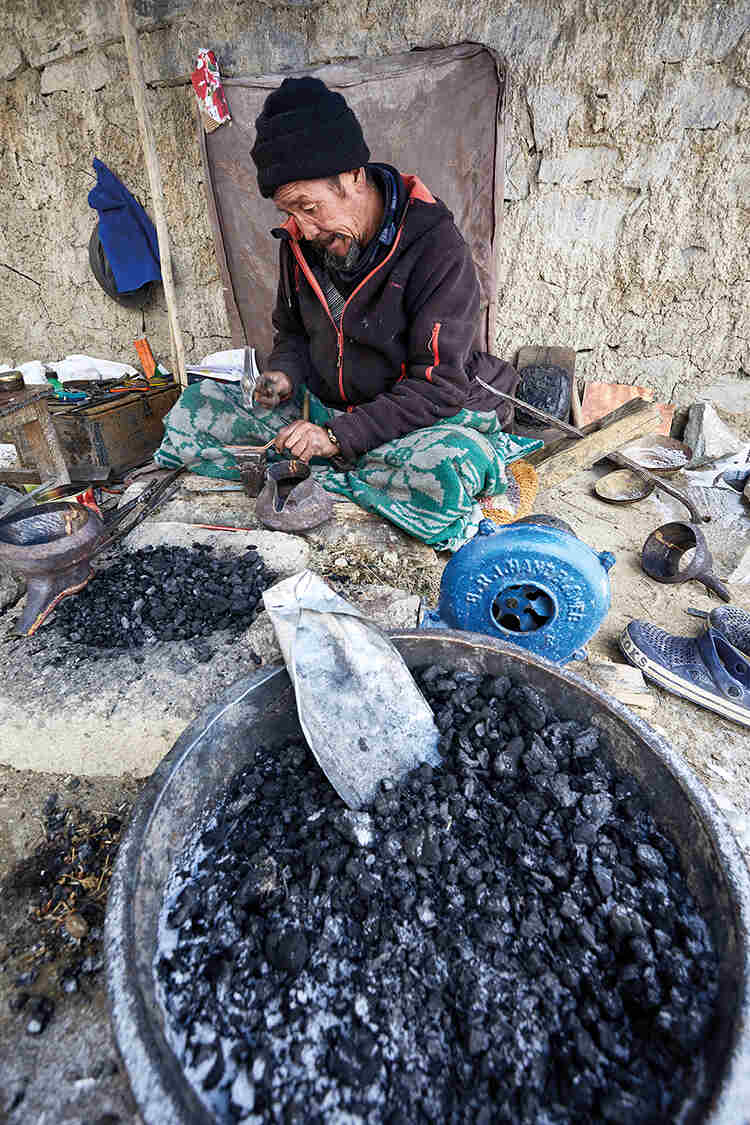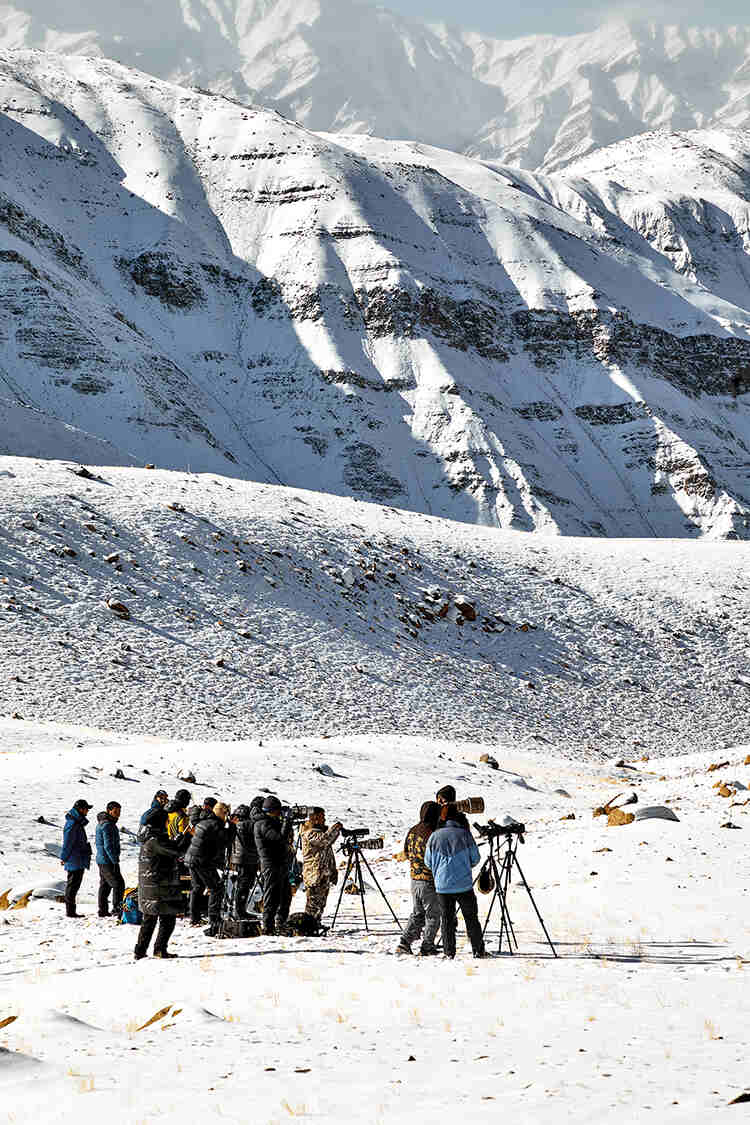
Snow leopards are rarely seen but much sought. Stuart Butler joins those on the trail of the big cat that stalks the high peaks of Ladakh
Last year, a snow leopard got into my livestock enclosure and killed 40 of my sheep in one night. It was a big problem for us.’ A light snow is falling but Rigzin Chosdup, who’s sat outside under the protection of a tarpaulin roof, seems too preoccupied with his work to notice the cold. He’s the last traditional copper worker in the valley and is making some ornamental pots for one of the village homestays.
We’re in the village of Rumbak, in Ladakh, a Trans-Himalayan region of India. As Rigzin talks, his weathered hands are constantly massaging, chopping and cutting at the metal he’s shaping into art. ‘My village is remote and tourists don’t visit and so we don’t really make any money from snow leopards. Not like they do in this village. For my livestock it would be better if there were no snow leopards.’ Rigzin sighs and shakes his head before continuing. ‘But now everyone here knows that for the environment, it’s better that the snow leopards are here.’

My first encounter with the elusive snow leopard came about 15 years ago. Heading way beyond the last village of central Nepal’s Langtang Valley, our small group had set up tents for the night in the snowy upper reaches of the valley. The night was cold and silent, and apart from our small group there was no other sign of life in this high-altitude valley of rock, ice and snow. And yet, when we woke in the morning, we discovered that we hadn’t been quite as alone as we’d thought. In the snow, all around the tents, were the unmistakable footprints of a snow leopard. No more than two to three metres from our tents it had circled us twice, perhaps looking for scraps to eat, before casually moving even higher up the valley. Awed by the knowledge that a large predator had moved silently around us in the night, we set out to follow the tracks, but of course, by then the ghost of the mountains had vanished.
Although it was only a set of footprints, it was enough to spark a curiosity in me that has never died down. In the years since that nighttime shadow moved through my dreams, I’ve returned again and again to the highlands of Asia – from the desert canyons of Upper Mustang to the ice lakes of Russia’s Altai Mountains and the open plateau of Tibet – searching for the ghost cat. And, the more time I spent in the Himalaya and mountains of Central Asia, the more I realised how little we really knew about this most iconic of big cats.

What we do know is that snow leopards inhabit an enormous swathe of mountainous terrain. Their territory stretches from Afghanistan’s Hindu Kush mountains in the west, through the Pamirs, Tian Shan and Karakorum of Central Asia, across the entire length of the Himalaya, much of the Tibetan plateau and right up as far as Mongolia and the mountains abutting the western shores of Siberia’s Lake Baikal. But exactly how many snow leopards there are in the world remains a mystery.
Due to their chameleon-like skills at blending into the background, as well as the unimaginably rugged terrain where snow leopards live, nobody has ever made more than an educated guess at worldwide snow leopard populations. The Global Snow Leopard and Ecosystem Protection Program has estimated that across the mountains of Asia there are perhaps a mere 4,000 to 6,500 individuals. However, they freely admit that some of the estimate is based on 30-year-old data that desperately needs updating.

One country that has recently undertaken a serious attempt to count the number of snow leopards living within its national borders is India. In early February 2024, the Wildlife Institute of India announced that the country was home to an estimated 718 snow leopards, which they think accounts for 10–15 per cent of the world total (meaning a world population of anything from 7,000 to 10,000). These new figures were reached after studying more than two million camera trap images and listening to eyewitness accounts from herders, military personnel, porters, tour guides and other local people. Around 2,000 camera traps were set up across 70 per cent of India’s snow leopard territory close to where snow leopard signs, such as scrape marks, scat and sprays, had been discovered. Using these techniques, the researchers were also able to conclude that Ladakh had the highest density of snow leopards in India and perhaps even the world. And so it was that a couple of weeks after the release of this report I found myself among the 6,000–7,000-metre peaks of Ladakh.
Mid-winter in Ladakh is not an easy time of year. Maximum daytime temperatures in the mountain areas where the leopards live frequently drop to around –20°C and below. However, winter was, I was reliably informed, the only time of year when you might realistically get a chance of glimpsing a snow leopard. The reason for this, according to Lobzang Visuddha, one of the founders of the Wildlife Conservation and Birds Club of Ladakh and owner of Ancient Tracks, a wildlife specialist tour company, is that ‘in winter, the blue sheep the leopards like to eat come lower down the mountain and into the valleys closer to villages. The leopards follow them and that makes them easier for us to find. Nowadays, in many of the villages, local people act as spotters and then let people know where they can be seen.’
Before heading into the mountains to once again try to see a snow leopard for myself, I spent a few days in the main town of Ladakh Leh, acclimatising to the oxygen-starved air. Armed with the knowledge that the worldwide population of snow leopards was a hazy figure, I was at least keen to find out more about snow leopard conservation in the land that might be their stronghold, so I went to talk to Rigzin Yangdol, a project manager from the Snow Leopard Conservancy India Trust. She explained that the prime threat faced by snow leopards is poaching, which though rare today in India, does still occur in other countries. In Chinese and Mongolian traditional medicine, it’s thought that the skin of a snow leopard can help cure rheumatism, and it’s estimated that every year in China (mainly Tibet), an estimated 103–236 leopards are killed for their skin. Other threats to leopards are retaliatory killings due to human–wildlife conflict, the overhunting of prey species and potentially climate change, although exactly how this last one will impact snow leopards isn’t yet clear.

Leaving aside climate change, Rigzin told me how in India, the biggest threat was from human–wildlife conflict. One of the key aims of the Snow Leopard Conservancy, she told me, is to mitigate this conflict, educate rural populations about snow leopards and ensure that villagers see an economic benefit in the presence of leopards.
Ladakh, like much of the Himalya and Tibet, follows Tibetan Buddhism and this, as Rigzin explained, was both a blessing and a curse for leopards. A blessing because Tibetan Buddhists believe in the sanctity of all life and most followers try not to kill any living creature. This means that although they might chase leopards away, they’d be reluctant to actually kill one and the Snow Leopard Conservancy uses this to their advantage. ‘Villagers in remote areas don’t always listen to what we say about not harming the leopards because we’re from the town and have a different life,’ Rigzin explained. ‘But, religion is important here and people listen to the monks. So, we make a point of going to the monasteries and explaining to the monks the key role leopards play in the environment and then the monks tell the people.’


But, this sanctity of all life does come with a problem, as Ringzin pointed out. ‘If someone sees a leopard attacking a blue sheep or another animal – or even on the carcass of an already dead animal – then they try to help it by chasing the leopard away. This means that the leopards use up a lot of energy hunting but then don’t get the meal. We try to explain to them that if they leave the leopard to make its kill, then it will hang around that carcass for some days feeding and that means tourists coming to see snow leopards will stay longer in the village spending more money.’
And this leads to her next point. Money. Good thoughts are one thing, but it’s money that makes the world go around; even in small Himalayan mountain villages. ‘When we started our work,’ Ringzin said, ‘we found that many people in rural areas were opposed to snow leopards because they killed their livestock. And if they lost their livestock, then people had greatly reduced incomes. So, our first task was to reduce livestock loss. Most attacks happen at night, when the livestock is in the corrals (small fenced compounds), but these were basic structures with no roofs so we set up a project to provide both the know-how and the material needed to construct leopard-proof corrals. Immediately, the number of livestock attacks was reduced and perceptions of leopards improved.’

But, she went on to say, it was the establishment of a homestay programme in the villages and the creation of snow leopard tourism that really changed things. ‘The homestay programme was our idea as a way of bringing income to remote villages with few other economic options. At first, it was just meant to be hosting passing trekkers but then, when our staff out working on surveys, as well as trekking and tour guides, started reporting seeing snow leopards in the valleys in winter, it encouraged the idea of snow leopard watching.’
And that has been an enormous success. Until recently, Ladakh was considered a summer-only tourist destination but now, thanks to the growing awareness of snow leopard tourism, the period between December and March is becoming increasingly popular with both Indian and international tourists keen to lay eyes on the ghost of the mountains. With the visitors staying in homestays, eating in the villages and buying snow-leopard-related handicrafts it’s bringing an additional income stream to villages at a time of year when there’s traditionally no other way of making money.

A few days after my conversation with Rigzin of the Snow Leopard Conservancy, I found myself in the village of Rumbak, where I’d fallen into conversation with the valley’s last traditional copper maker. I’d come here because word had got out that a female snow leopard had killed a blue sheep nearby and that she
was likely to stay near the carcass for a few days. I’d spent the time since dawn with my guide, Tsering Namgyal, scanning – without luck – the nearby rock faces for any sign of movement. Finally though, with the cold eating into me and my bones starting to feel like they’d turned to ice, I suggested that we returned to our homestay to warm up. ‘Two more minute,’ said Tsering, ‘I know she’s here. She’s watching us. I just know it.’ Stamping my feet to try to keep warm I agreed to just a few more minutes.
Sweeping his telescope up and down the mountain slopes one last time, Tsering suddenly stopped and caught his breath, ‘She’s here,’ he quietly whispered and pointed toward the cliff face. All thoughts of hypothermia gone, I peered through the viewfinder of the telescope and there, staring straight at me from just a few hundred metres away, was a dusky white snow leopard. And then, as I watched, spellbound, something stirred behind her, and two tiny balls of fur popped their heads up from behind Mum. The ghost of the mountains had babies.




